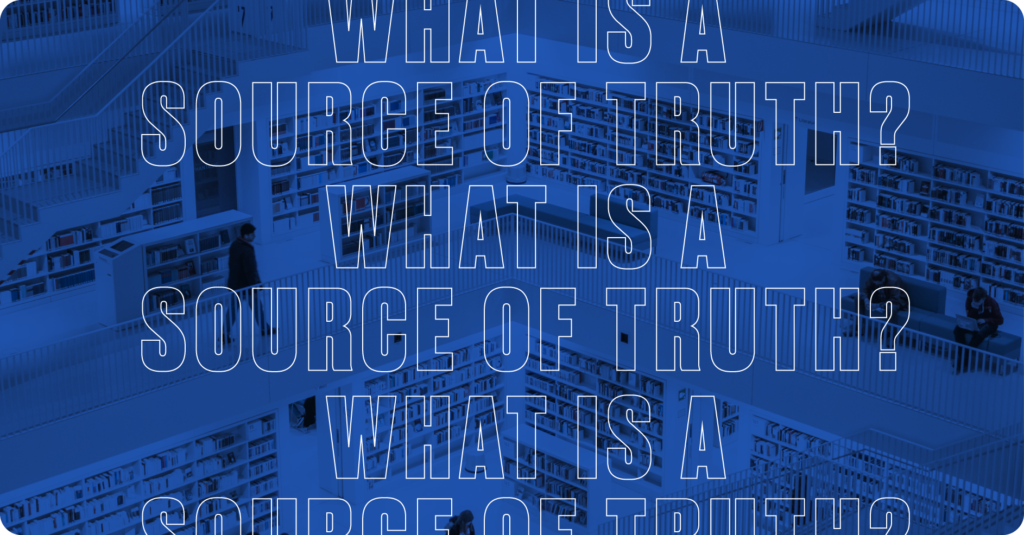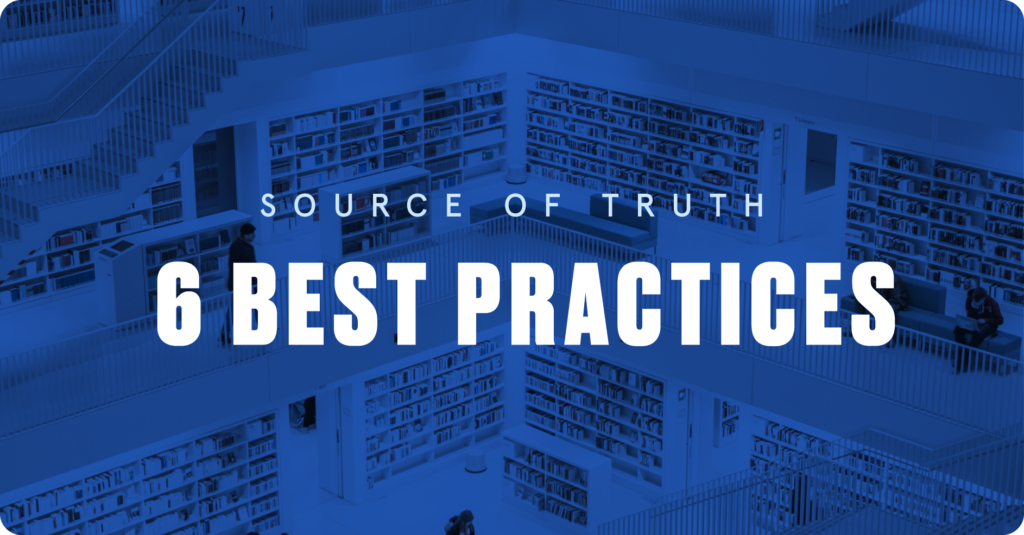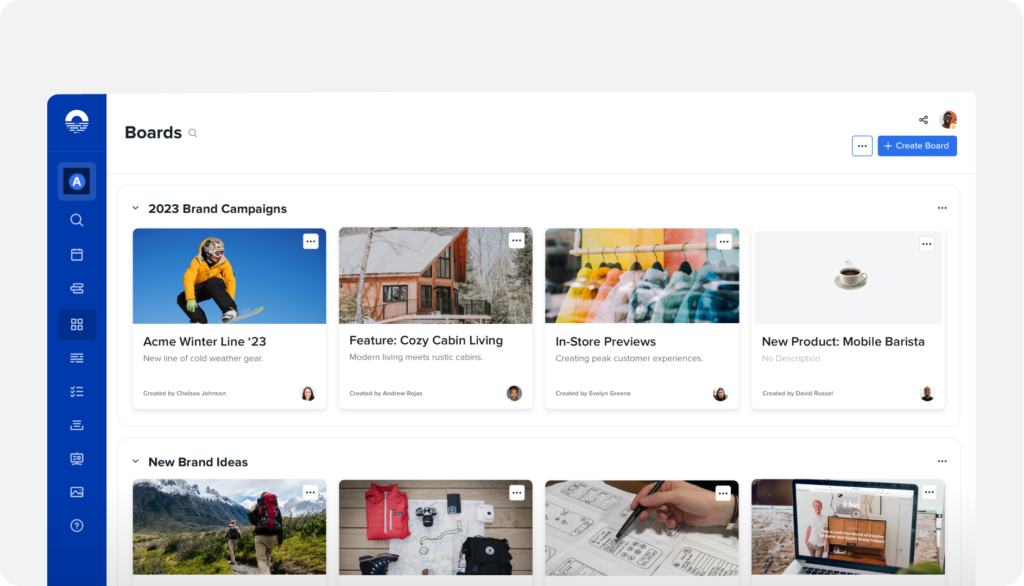by Lee Dussinger
Without a single source of truth in marketing, you’re in the dark. Not knowing where to find accurate information is the downfall of effective marketing campaign planning or analysis. This undermines everyone on the team, from the people executing strategies – all the way to leadership. At any time, any team member should be able to access the following information:
- The goal of the current work
- The work that was done previously
- The outcome of previous work
- What other work is being produced simultaneously
Creating a marketing single source of truth centralizes crucial plans and data. Beneficial for every step of the process – from creating pieces of content to analyzing results – this ensures that everyone works from the same consistent source of information. Simply put, with a source of truth, you always know where to look for information – and you always know it’s correct.
While any organization can benefit from it, the scope and structure of an enterprise organization makes it essential. Explore what creating a single source of truth in marketing entails, the benefits, best practices, and a real-life use case!
Big picture: what is a source of truth?

In marketing, a source of truth is the name for the central location that provides the definitive answer to questions about briefing, content, and results. Also called a single point of truth, it is typically a formal dashboard or platform – although in less ideal situations it can be something as simple as a Google doc or spreadsheet.
While source of truth discussions typically focus primarily on data management, our single source of truth definition is broader. This definition encompasses a wider range of information that is necessary for marketing planning and analysis. For example, it can convey data like the number of engagements from a social media campaign – or it can showcase a relevant marketing campaign that was run years ago.
In order for any marketing platform or dashboard to function as an authoritative source of truth, all of these need to be true:
- Everyone uses it as their go-to source
- It is available to everyone who needs it
- The data and information are fully accurate
- It is updated with the latest information (results data, briefs, or real work)
Single Source of Truth Benefits: Plan, Create, Calendar & Analyze

To help you better understand what a source of truth is and the impact it can have, we’re highlighting the content operations categories where we see the biggest impact for our clients: planning, creating, calendaring, and analysis.
Planning – During the planning phase, a central source of truth provides several benefits. Since it serves as a historical record of all past campaigns, you can use it to guide an upcoming activation you’re planning by reusing key elements or just by referencing what worked before. In addition, your marketing briefs and documentation also have a place in the platform so that they can be accessible to the entire team.
Key Benefit: Easily take inspiration from past campaigns and store briefs and other key documents
Creating – When creating the individual pieces of content that comprise a campaign, one of the most effective sources of inspiration is yourself. That’s why a truly authoritative source of truth should also include the complete record of the posts, ads, videos, and images that comprised past campaigns.
Key Benefit: Easily take inspiration from past campaigns
Calendaring – A shared calendar is essential for organizations that have multiple teams or individuals publishing content. In order to prevent content gaps or collisions, everyone needs to see what messages are going to market and at what times. Adding a central calendar to your single point of truth platform means that there is one agreed upon place to get all the information about how your brand appears in the market on any given day.
Key Benefit: Prevent content gaps and content collisions
Analysis – Having a source of truth for data is essential. Your campaign KPIs belong in a central dashboard so that a single set of numbers can be used for campaign post-mortem and analysis. By having all teams working from a single set of data, your organization is guaranteed to be making decisions with consistent information.
Key Benefit: Ensure marketing analysis is done using identical data across the organization
6 General Best Practices

These are the general best practices that will lead to success when setting up a single source of truth for marketing in your organization:
1. Consolidate Everything – A cornerstone benefit of a source of truth is that everyone knows where to go for anything. Not only does this give your team certainty, but it also saves them time scavenger hunting to find the right version or the key info. The first step of setting it up is to consolidate as much information as possible in the platform right away.
2. Define Rules and Roles – Establishing what individuals or what teams will be able to make what changes is important. Some organizations have a source of truth that anyone can edit at will – while others can only be modified by key stakeholders. Make that decision when you start. Leaving this up to chance can cause confusion and even put the integrity of the information at risk.
3. Have a Place for Free-Form Ideas – Maintaining a record of past work is one of the key benefits of a single source of truth. However, you also need space in your software or documents for early stage ideas. Without a dedicated space, you’ll end up planning in another space and creating a secondary repository for ideas. By having your notes alongside campaigns, you can look back at the thought process that led to your published marketing campaigns. This serves as a way to understand why you made the choices you did, which can be helpful when planning going forward.
4. Settle Data Discrepancies and Taxonomy – As part of the set-up process, the marketing organization needs to be in agreement about what data you’re using – and what you’re calling it. For example, from a paid ad, you’d need to decide if you’re counting total impressions, unique impressions, or both. Settling this issue before inputting any data is key.
5. Update It Regularly and on a Schedule – Your central source of truth only works if it is updated with the latest information and marketing campaigns. To ensure that it is accurate and up-to-date, best practices is that you’ll want to schedule when you update it. This can be a set amount of time after a campaign ends – or a recurring weekly task.
Of course, if you choose to invest in a software solution, it can cut the busy work of updating your point of truth. Not only does this give you time back, but it also guarantees that your crucial information is always up-to-date.
6. Invest in the Technology – By investing in source of truth software, your organization gets a better tool for this essential business function. While you can cobble together a solution for free, it will be less effective and require more manual updates to function. A purpose-built piece of tech delivers convenience and enormous value-add potential.
Use Case: International Cosmetics Company
Looking at a real example can help to understand the meaning of a single source of truth. To provide clarity, we’re highlighting how one of our clients – a global cosmetics brand – uses Opal as their source of truth.
As one would expect, space on their highly-visited website is prime digital real estate. In order to coordinate which of their numerous regional teams gets what placements, they employ a central source of truth. Their global communications team maintains a fully visible shared calendar that illustrates what regional teams are going to be shown on which spaces, with what content, and for how long. That central calendar is the de facto place to go for information on what products and regions will be featured in what spaces on the website.
In addition to that primary example, they also use their source of truth to share these schedules with organizational leadership. The Opal platform enables their global communications team to share auto-build marketing presentations of their plans with anyone inside or outside of the organization.
Their single point of truth ensures that all marketing teams understand exactly what is being published on the website and when – while ensuring that executive leadership can have as much visibility as they desire.
Discover the Opal Platform

Building a single source of truth in marketing unlocks superior campaign planning, creation calendaring, and even data analysis.The bigger your organization and the more complicated your work, the more imperative this safeguard becomes.
If you’re looking to invest in a source of truth software platform, Opal delivers that and so much more. Opal is the platform that marketers use to plan, create, and calendar every facet of their content. We’re proud to be the platform trusted by brands like Target, Microsoft, Starbucks, and many more.
If you’d like to discover how Opal can bring complete clarity to your marketing, our team is here to help. Request a customized demo with a product expert right here!


